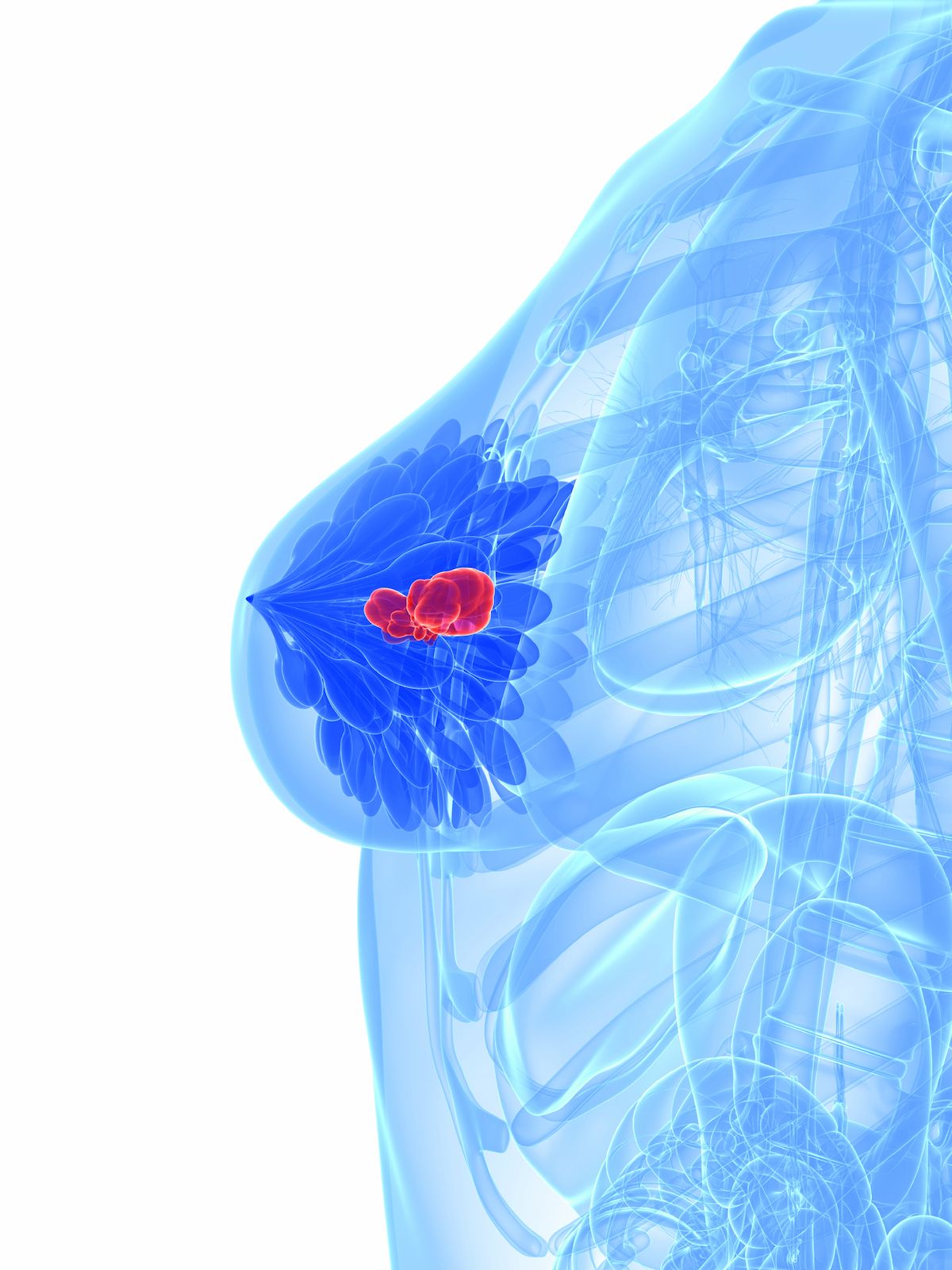
Patients with hormone receptor-positive breast cancer who were treated with samuraciclib plus fulvestrant saw tumor activity.
The phase 2 modular study (NCT03363893) showed clinical activity for patients with hormone recepotr (HR)-positive breast cancer who were treated with the CDK7 inhibitor samuraciclib (CT7001) plus fulvestrant (Faslodex), and who were previously heavily pretreated with CDK4/6. Additionally, the TP53 mutational status helped predict outcomes for the combination therapy, according to a presentation from the 2021 San Antonio Breast Cancer Conference.1
Findings showed 72% (18 of 25) of evaluable patients had tumor shrinkage. In 19 patients (76%) expressing the TP53 wild type and 6 patients expressing TP53 mutant type, the median PFS was 32 weeks and 7.9 weeks, respectively (HR, 0.17; 95% Cl, 0.05-0.53; P = .0008). When patients were stratified by liver metastasis at baseline, the investigators found median PFS was not reached in 17 patients who had no liver metastases (≥ 48 weeks); in 14 patients with liver metastases the median PFS was 11.9 weeks (HR, 0.16; 95% CI, 0.05-0.59; P = .0021). Liver metastasis is a known risk factor for poor prognosis in HR+ breast cancer. Future studies will evaluate whether liver metastases is predictive for samuraciclib-based therapy.
Metastatic HR+ and HER2-negative breast cancer treatment following progression typically shows unsatisfactory efficacy and toxicity.2-4
“On average, we get about a 2 month progression-free survival [PFS] with fulvestrant in patients who’ve become resistant to CDK4/6 inhibitors,” Charles Coombes, MD, director of Cancer Research at the UK Imperial Centre said during a presentation of the data. Coombes noted that although patients tolerate hormonal therapy well, efficacy is limited after CDK4/6 inhibitor therapy.5
Samuraciclib is a once-daily, oral, small molecule selective inhibitor of CDK7, which has shown synergistic activity with hormonal therapy in HR-positive breast cancer models. In particular, the drug shows activity when combined with tamoxifen or fulvestrant. Coombes said the mechanism of action for samuraciclib had 3 effects on ER-positive breast cancer cells: inhibition of serine phosphorylation, inhibition of CDK1, and inhibition of cell transcription.
The study aimed to find the dosing regimen of the samuraciclib plus fulvestrant combination and to investigate signs of preliminary activity and biomarkers.
The study enrolled 31 patients who received either 240 mg of samuraciclib by mouth once daily plus 500 mg of fulvestrant every 4 weeks (n = 6) or 360 mg of samuraciclib by mouth once daily plus 500 mg of fulvestrant every 4 weeks (n = 25). To be considered eligible, patients must have been aged at least 18 years, had a confirmed histology of metastatic or locally advanced ER-positive and/or PGR-positive, HER2-negative breast cancer. Patients must also have had prior CDK4/6 inhibitor therapy, at most 1 line of chemotherapy or at most 2 lines of endocrine therapy and have had no prior fulvestrant treatment.
The median age for patients was 60 years (range, 41-81). All patients had 1 prior endocrine therapy, and 13% of patients had 2 lines of endocrine therapy.
Investigators observed a clinical benefit rate (CBR) in 36% of patients at 24 weeks. Patients without liver metastases had a CBR of 55%. Coombes noted that the CBR rose from 36% to 53% when excluding patients with a TP53 mutation.
Coombes elaborated, “P53 reacts to the stress induced by CDK7 inhibition…When [P53] is wild type, [it] responds to CDK7 inhibition to induce apoptosis and senescence. This is important because, at this stage of the disease and ER+ breast cancer, nearly 70% of patients still have wild type P53.”
The most common adverse events (AEs) were reversible, low-grade gastrointestinal (GI) events. The most common AEs were diarrhea (90%), nausea (81%), vomiting (74%), and fatigue (36%). Few grade 3 or higher AEs occurred and diarrhea (19%) and nausea (10%) were the most common. Six patients discontinued treatment because of GI-related AEs. Of 11 patients who had dose reductions, 9 continued treatment. No neutropenia or significant myelosuppression was observed.
Samuraciclib has been granted fast-track status by the FDA, said Coombes. Future clinical studies will evaluate samuraciclib in combination with oral selective estrogen receptor degraders to extend the limited PFS of a single–agent endocrine therapy.
References
1. Coombes, Charles. Study of samuraciclib (CT7001), a first-in-class, oral, selective inhibitor of CDK7, in combination with fulvestrant in patients with advanced hormone receptor positive HER2 negative breast cancer (HR+BC). Presented at 2021 San Antonio Breast Cancer Symposium; December 9, 2021; San Antonio, TX
2. Cook MM, Al Rabadi L, Kaempf AJ, Saraceni MM, Savin MA, Mitri ZI. Everolimus plus exemestane treatment in patients with metastatic hormone receptor-positive breast cancer previously treated with CDK4/6 inhibitor. Oncologist. 2021;26(2):101-106. doi:10.1002/onco.13609
3. Dhakal A, Antony Thomas R, Levine EG, et al. Outcome of everolimus-based therapy in hormone-receptor-positive metastatic breast cancer patients after progression on palbociclib. Breast Cancer (Auckl). 2020;14:1178223420944864.. doi:10.1177/1178223420944864
4. Cortes J, Cescon DW, Rugo HS, et al. Pembrolizumab plus chemotherapy versus placebo plus chemotherapy for previously untreated locally recurrent inoperable or metastatic triple-negative breast cancer (KEYNOTE-355): a randomised, placebo-controlled, double-blind, phase 3 clinical trial. Lancet. 2020;396(10265):1817-1828. doi:10.1016/S0140-6736(20)32531-9
5. Whittle JR, Vaillant F, Surgenor E, et al. Dual targeting of CDK4/6 and BCL2 pathways augments tumor response in estrogen receptor-positive breast cancer. Clin Cancer Res. 2020;26(15):4120-4134. doi:10.1158/1078-0432.CCR-19-1872
"breast" - Google News
December 10, 2021 at 11:02PM
https://ift.tt/3DHhsQH
Samuraciclib Plus Fulvestrant Shows Tumor Shrinkage in HR+ Breast Cancer - Cancer Network
"breast" - Google News
https://ift.tt/2ImtPYC
https://ift.tt/2Wle22m
Bagikan Berita Ini














0 Response to "Samuraciclib Plus Fulvestrant Shows Tumor Shrinkage in HR+ Breast Cancer - Cancer Network"
Post a Comment